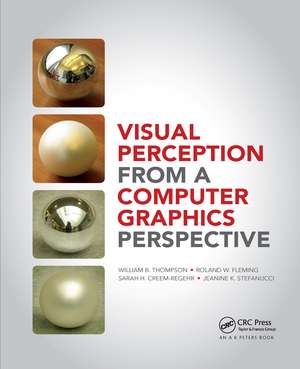Visual Perception from a Computer Graphics Perspective
Autor William Thompson, Roland Fleming, Sarah Creem-Regehr, Jeanine Kelly Stefanuccien Limba Engleză Paperback – 30 sep 2020
Preț: 269.89 lei
Preț vechi: 371.99 lei
-27% Nou
Puncte Express: 405
Preț estimativ în valută:
51.65€ • 56.08$ • 43.39£
51.65€ • 56.08$ • 43.39£
Carte tipărită la comandă
Livrare economică 22 aprilie-06 mai
Preluare comenzi: 021 569.72.76
Specificații
ISBN-13: 9780367659288
ISBN-10: 036765928X
Pagini: 550
Dimensiuni: 191 x 235 mm
Greutate: 1.02 kg
Ediția:1
Editura: CRC Press
Colecția A K Peters/CRC Press
Locul publicării:Boca Raton, United States
ISBN-10: 036765928X
Pagini: 550
Dimensiuni: 191 x 235 mm
Greutate: 1.02 kg
Ediția:1
Editura: CRC Press
Colecția A K Peters/CRC Press
Locul publicării:Boca Raton, United States
Public țintă
Academic and Professional Practice & DevelopmentCuprins
INTRODUCTION: Overview. BUILDING BLOCKS: Visual Sensitivity. 2D Image Features. Color. 2D Motion. Stereo and Accommodation. SURFACES AND MOVEMENT: Perspective. Texture. Illumination, Shading, and Shadows. Perception of Material Properties. Motion of Viewer and Objects. Pictorial Space. PERCEPTION OF HIGHER LEVEL ENTITIES: Spatial Orientation and Spatial Cognition. Perception and Action. Object and Scene Recognition. Visual Attention and Search. Event Recognition—Inanimate. Event Recognition—Biological. References. Index.
Notă biografică
William Thompson, Roland Fleming, Sarah Creem-Regehr, Jeanine Kelly Stefanucci
Recenzii
This is a fabulous book written by the right people, and if I had to pick only three books for my desk, this would be one of them.
—Peter Shirley, author of Fundamentals of Computer Graphics
This is the first book on perception to build on the need to understand how images are formed in order to understand how they are perceived and used. The discussions of applications to computer graphics are the icing on the cake of a broad and often deep treatment of the ever-growing science of human visual perception.
—Daniel Kersten, Department of Psychology, University of Minnesota
Finally, here is a book that offers a thorough introduction to visual perception specifically geared toward the graphics practitioner. It should be required reading for anyone serious about computer graphics.
—Alexei A. Efros, School of Computer Science, Carnegie Mellon University
It matches basic vision texts in coverage and adds the unique point of view of production: how would you create this scene? It is an excellent resource and new source of ideas about how vision works and how computer graphics can best take advantage of the properties of the human visual system.
—Patrick Cavanagh, Université Paris Descartes and Harvard University
—Peter Shirley, author of Fundamentals of Computer Graphics
This is the first book on perception to build on the need to understand how images are formed in order to understand how they are perceived and used. The discussions of applications to computer graphics are the icing on the cake of a broad and often deep treatment of the ever-growing science of human visual perception.
—Daniel Kersten, Department of Psychology, University of Minnesota
Finally, here is a book that offers a thorough introduction to visual perception specifically geared toward the graphics practitioner. It should be required reading for anyone serious about computer graphics.
—Alexei A. Efros, School of Computer Science, Carnegie Mellon University
It matches basic vision texts in coverage and adds the unique point of view of production: how would you create this scene? It is an excellent resource and new source of ideas about how vision works and how computer graphics can best take advantage of the properties of the human visual system.
—Patrick Cavanagh, Université Paris Descartes and Harvard University
Descriere
Suitable for readers studying or working in the fields of computer graphics and visualization, cognitive science, and visual neuroscience, this book provides an introduction to human visual perception. It focuses on how computer graphics images are generated, rather than solely on the visual system’s organization, so the text provides a more dir
